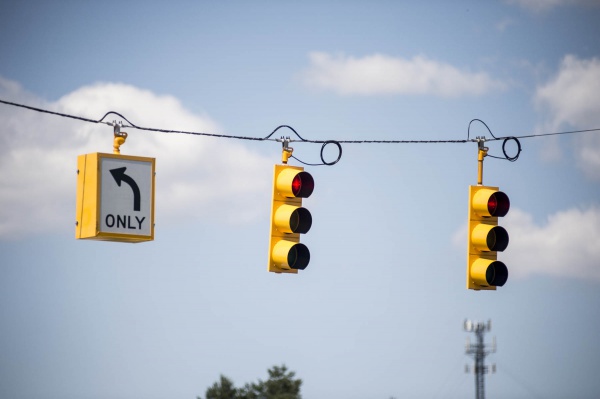820 - Traffic Signals
GENERAL
-Reserved-
MATERIALS
Traffic Signal Installation, Steel Strain Pole Band Clamps
Steel band clamps are used for traffic signal span wire installation on steel strain poles. Clamps must meet the material requirements in Special Detail SIG-010-A “Span Wire T.S. on Steel and Wood Poles”, Detail B, Pole Band Clamps on Steel Pole”, which specifies ASTM A36 steel bands using ASTM A325 galvanized steel bolts.
Pole band clamps must be stamped with identification that is traceable back to the manufacturer, which can be used to determine the month and year of clamp manufacture. The stamping method must be a low stress stamping method. The stamp cannot be located near the bolted flange, must be located near the center of the backside clamp from traffic on the outside face, and be visible after galvanizing. Any questions regarding clamp identification can be directed to the Traffic Signals Unit at 517-322-3360.
The minimum inside bend radius for cold formed members must be at least 1.5 times the material thickness (or 3/8 inches).
CONSTRUCTION
Notification of Traffic Signal Work
It is the contractor's responsibility to notify MDOT’s Statewide Signal Shop prior to beginning any signal work. Traffic signal projects include a note in the project plans that state the following, "Contact MDOT (and any other maintaining agency) seven (7) working days prior to start of construction and seven (7) working days prior to signal activation.” Appropriate contact information is indicated in the plan notes. The seven day time frame will allow for coordination between the contractor and the Statewide Signal Shop for installation and inspection of traffic signal work. It is recommended that these notification requirements be discussed at the pre-construction meeting.
The Statewide Signal Inspector must be on-site to help to ensure that unsafe conditions with the traffic signals are not utilized or incorporated into the project work and to protect the safety of the public. Any work done incorrectly will need to be corrected at the contractor's expense.
If an inspector from MDOT’s Statewide Signal Shop or appropriate maintaining agency is not on site when a contractor is performing signal work, the project representative (MDOT/consultant engineer or inspector) should stop the signal work until verification of prior notice to MDOT has been confirmed. Construction staff should call the Statewide Signal Shop at 517-322-3360 to verify whether inspection notification requirements have been met. If prior notification was not provided by the contractor, form 1165, Notice of Non-Compliance with Contract Requirements is to be issued until the contractor properly notifies the Statewide Signal Shop and necessary inspection arrangements have been made.
To ensure proper coverage and discussion Jim Kwapiszewski, should be invited to preconstruction meetings for projects that involve any traffic signal work.
MEASUREMENT AND PAYMENT
-Reserved-
